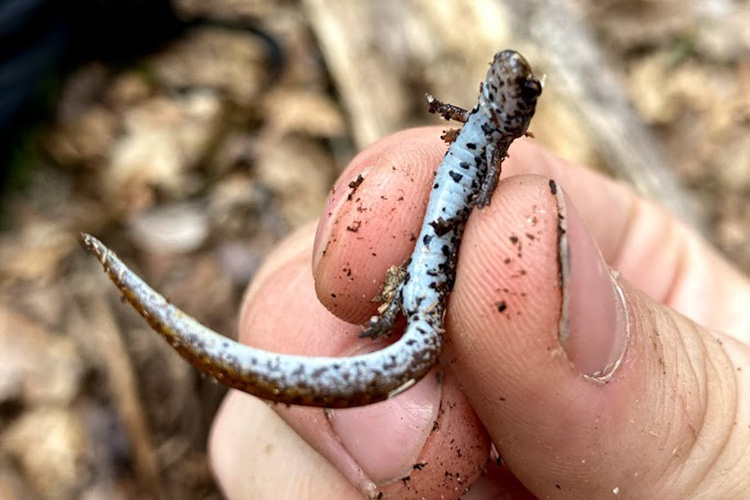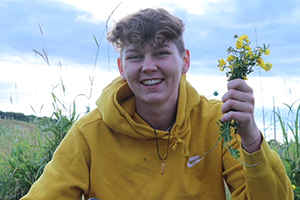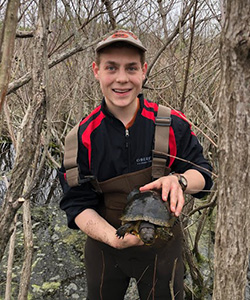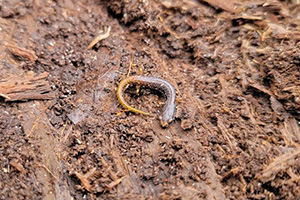
This four-toed salamander (scientific name Hemidactylium scutatum) is found statewide in Wisconsin, but had never been spotted in Ozaukee County until UWM students Morgan Schmanski and Joey Cannizzaro saw one on a class trip to the UWM Field Station adjacent to the Cedarburg Bog. (Photo courtesy of Morgan Schmanski)
Exploring the outdoors can lead to some interesting scientific finds. Look what happened when Isaac Newton saw that apple fall from the tree.
UWM students Morgan Schmanski and Joey Cannizzaro made an interesting and rare find just by digging in the dirt.
Schmanski, who graduated in December in conservation and environmental sciences, and Cannizzaro, a graduate student in biology, were on a hike at the UWM Field Station last fall as part of a conservation and environmental science field methods class. Schmanski, who was also taking a class in mineralogy, spotted an interesting rock and decided to check it out.
Tail spotted in the dirt
Digging in the soft dirt around the rock, Schmanski saw the tail of an unusual creature underneath. Classmates told her it was probably a dead snake, but she was intrigued enough to mention it to biology graduate student and herpetologist Cannizzaro when the group went to lunch.

“I was like, ‘Dude, you need to look at this,’” Schmanski said. “So Joey put his hands in the dirt and found this little guy.”
The “little guy” turned out to be a rare four-toed salamander, the first one ever documented in Ozaukee County.
“Salamanders in general are really hard to find,” Cannizzaro said. “They don’t call like frogs do, and they’re underground most of the year, so they’re very, very hard to find.” He’s familiar with amphibians through his work with frogs in Associate Professor of Biology Gerlinde Höbel’s lab.
“I was ecstatic,” said Cannizzaro. “That’s an understatement,” Schmanski added with a laugh.
Find confirmed
The four-toed salamander (scientific name Hemidactylium scutatum) is distinguished from other local salamanders by its gray and white speckled belly.

Gretchen Meyer, director of the UWM Field Station who was leading the class, which was actually focused on the beech forest that day, confirmed the find. The identification was later further confirmed by other researchers who verified what the students had found. The salamander was photographed and returned to its home with GPS coordinates documented.
Cannizzaro believes that the field station, which is adjacent to the Cedarburg Bog, provides a good environment for the rare salamander because it has an abundance of sphagnum moss where the females like to nest, so more of the rare salamanders may turn up.
Hard to find
The finding was submitted to the journal Herpetological Review to be published as a new county record. That issue is scheduled to come out March 22.
“These salamanders are found statewide where older forest cover is intact, but distribution records are very spotty because they are hard to find,” said Gary Casper, biologist and associate scientist at the field station. “In the southern half of the state they often occur as ‘glacial relicts’ in forest patches that once were connected to continuous forest cover but are now isolated in moister micro-climates within prairie regions,” he added. “This is a new county record, and it is nice that the students recognized it as such and documented it.”
The nearest other documented populations are in the North Kettle Moraine State Forest, according to Casper.
Cannizzaro, who has been interested in reptiles and amphibians since he was a child, is hopeful that other members of the rare salamander family will be found at the UWM Field Station or nearby Cedarburg Bog. “The habitat is right for them, so it’s likely there are more.”
“Happy and fortunate”
He’s also amazed that with all the research that biologists have done in the area over the past 50 years, the salamander hasn’t been previously discovered, but it’s tiny and can stay well-hidden.
Both he and Schmanski really appreciated the opportunity to take the class and spend time at the field station. Each session focused on different topics, including trees and insects.

“It’s a great class to take. I’m just very happy and fortunate that the university offers a class like that at the field station,” Cannizzaro said.
Schmanski liked the fact that students in the class really bonded and formed a community. “That’s why I knew I could ask Joey about what I’d found.”
“We spend a lot of time outside during the class and the students find many interesting things, but finding a four-toed salamander was exceptional,” said Meyer. “This was an exciting find, both for the two students who found it and for the rest of the class who got to see it and learn about it.”
Although Schmanski graduated in December, she plans to eventually return to school to study more about conservation because she has a great interest in the environment and really felt she learned a lot, especially this past semester, she said.
Taking the class at the field station and finding the salamander really helped wrap up her undergraduate education nicely.
“Gretchen was definitely a phenomenal professor. She just made everything I’ve learned in the past four years come together.”
By
Link to original story: https://uwm.edu/news/uwm-students-make-a-rare-find-while-on-a-class-hike/
